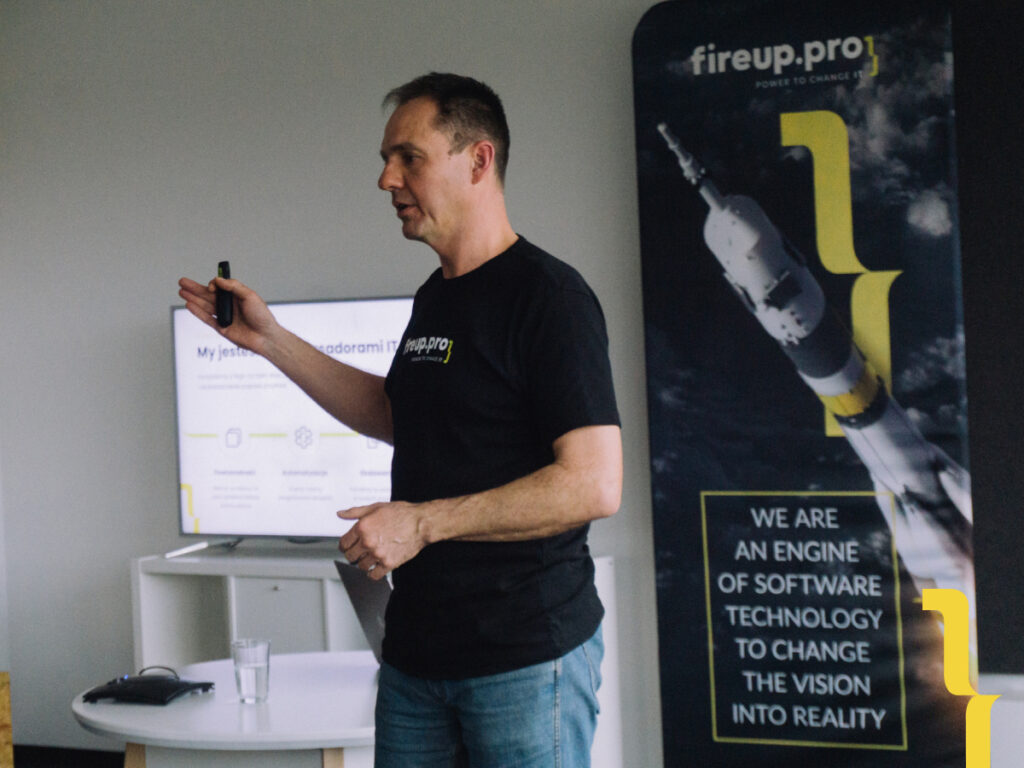In the digital era, where complex applications and systems are omnipresent, the ability to track their state and behavior becomes not only useful, but essential. Application observability and monitoring are key components, that allow fireup.pro engineers and IT specialists to:
- Gain a deep understanding of the workings of their systems
- Ensure their reliability
- Quickly diagnose potential problems
These two terms, although often used interchangeably, have subtle differences and serve different purposes. Let’s delve into their definitions, applications, and significance in the context of modern applications.
Understanding IT monitoring: an introduction to tools and objectives
Monitoring is the process of tracking and evaluating the performance of a system in real-time or retrospectively to ensure its proper functioning and respond to any abnormalities.
The key question is: „What is happening?”. To understand this, IT experts use a variety of tools, such as Grafana for viewing metrics, Grafana Tempo for tracing, and Kibana for log analysis. These tools provide insight into important aspects of the system, such as call parameters, delays, and an overview of significant events, including deployments or changes in infrastructure. IT Application monitoring thus enables not only the identification of problems, but also the analysis of their causes and the timely implementation of corrective actions.
The significance of observability: The key to understanding the state of applications
Observability, in the context of applications and IT systems, refers to the ability to understand the internal state of a system based on external outputs. In other words, it answers the questions: „Is it working?” and „If not, why not?”. To accurately respond to these questions, IT experts analyze various indicators.
For example, API response codes like „200” indicate correct operation, while other codes may signal errors. Response times and the number of API calls are other key metrics that provide insight into system performance and load. Network traffic can also offer information about the intensity of system use and potential threats. If something is not working, observability allows us to identify the problem and then analyze its cause. As a result, it is not only a diagnostic tool but also a crucial strategy for ensuring the reliability and efficiency of applications.

How to effectively monitor and observe your application: IT management tools and strategies
To effectively monitor and observe an application, we primarily need the right data and IT management tools. The key types of data are metrics, traces, and logs, often referred to as the „Metrics, Traces, Logs” trio. OpenTelemetry provides an excellent platform for collecting these data types in a uniform and standardized manner.
Implementing this process starts with publishing metrics — both API-related and infrastructure metrics, such as CPU usage, memory, network throughput, and IO operations. Then, it is crucial to publish logs enriched with the right context — this can be achieved by adding identifiers such as trace id or span id to metrics, allowing for tracing and precise tracking of application behavior.
Once the data is collected, its centralized storage in a system capable of analysis, visualization, and problem detection is important. By using tools to analyze this data, we can identify anomalies, early symptoms of problems, and potential errors. Finally, to stay up-to-date, the system should have notification functions for any irregularities, allowing for quick response to potential issues. Data visualization, using tools like dashboards, enables intuitive understanding of the application’s state and behavior over time. Consequently, a properly configured monitoring and observability strategy is key to the health and efficiency of any application.
IT automation: is it possible to automate system maintenance?
Current technology allows for significant automation in maintaining complex IT systems. Starting with notifications, through setting alerts based on metrics, the system can autonomously inform us about potential problems. These alerts can then be published in various formats, from Slack messages, through emails, to SMS, enabling quick team response.
In system maintenance, IT automation plays a crucial role. Mechanisms like autoscaling allow the system to adjust the number of instances in response to load, while auto-restart functions can quickly restore a service in case of failure. In situations where specific instances start causing issues, the system can automatically detach them, and in extreme cases, apply a rollback to an earlier, stable version.
Although IT automation is immensely valuable, it cannot entirely replace human input. In exceptional situations, manual intervention is necessary, and regular monitoring of services by specialists allows for a deeper understanding of system operations and the detection of subtle anomalies.
Modern technologies, such as Machine Learning and Artificial Intelligence, enable the automatic detection of concerning trends, providing us with tools for even more effective management and maintenance of systems.
Incidents, their metrics and importance in the Digital System Reliability
Incidents in IT systems are inevitable, but through rigorous monitoring and appropriate metrics, we can quickly identify, respond to, and minimize their impact. The first step is incident reporting and measuring MTTR (mean time to repair) – the average time from when a user reports a problem to when it is resolved. However, other metrics such as MTTD (mean time to detect), which determines how long it takes to detect a problem after its occurrence, and MTTN (mean time to notify), indicating the speed of incident notification, are equally important.
It’s worth noting that machine learning and artificial intelligence play a key role in problem identification. Introducing the MTTP (mean time to prevent) metric reflects the time required for ML/AI algorithms to detect a concerning trend before it becomes a problem.
However, presenting these metrics is a challenge. Interpreting numerical indicators independently, without deep system knowledge, can lead to incorrect conclusions. To get a complete picture, it’s essential to combine the presentation of the system architecture with metrics and events in a single view. This approach allows for a full understanding of how the system is built, how it operates, and what actions have been taken within it. As a result, this enables effective analysis, response, and continuous improvement of the Digital System Reliability.
@fireuppro Sad but true 🙈 #video #programowanie #coding #codinglife #codinghumor #humor #programista #fy #fyp #backend #frontend #dc #dlaciebie #work #officelife #programming #junior #dev #socialmedia #codingmeme #meme #tester #bug #bugs ♬ original sound – </devs> – <codevs2.0/>
Conclusions in the context of monitoring and automation of IT systems
In today’s dynamic IT environment, it’s crucial to ask the right questions. „What to do to know that everything is working well?” The answer lies in metrics and indicators that show us the real-time state of the system. However, merely confirming that „everything is fine” is not enough. We need to understand what specifically indicates that the system is functioning correctly.
Effective system management and responses to these issues can be ensured by automation supported by appropriately configured alerts. The higher the level of automation in the process, the less manual intervention is required, leading to greater efficiency and fewer human errors. Aiming for a 100% IT automation rate should be the goal of every organization. By relying on technology, one can focus on innovation and improvement, rather than on reactive problem-solving.

